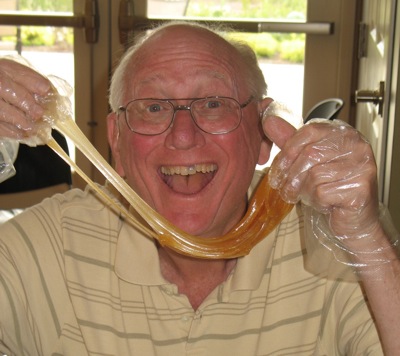Thursday, September 24th, 2009
Coyote decoys good for scaring away Canada geese
By Nancy Allen
Decoy coyotes are proving to be a good way to scare off Giant Canada Geese for folks who don't want them or their droppings in their yards and ponds.
The geese eat grass and produce large droppings that routinely litter sidewalks, walkways and yards throughout the Grand Lake area. They also aggressively defend their nests.
"There are actually 11 different species of Canada goose, but the only one that causes problems is the Giant Canada Goose, the ones that get between 11 and 13 pounds," Marne Titchenell, an OSU Extension wildlife specialist, said during Wednesday's Farm Science Review in London, Ohio.
A couple of events have combined to make the birds prevalent again after being extirpated from Ohio by 1900, Titchenell said.
In 1918 the federal migratory bird act put protections on almost all migratory birds, including the Giant Canada Goose, meaning residents couldn't harm them or their eggs or offspring, Titchenell said. The state of Ohio also dedicated three state-protected areas for the birds in 1956. By 1979, the Giant Canada Goose was nesting in half of Ohio's 88 counties, she said.
The use of coyote decoys to scare off the geese has proved effective, she said.
She said a high school in Ohio was having problems with geese coming on to the school's football field and eating the grass and making a mess with their droppings. As soon as school officials put the coyote decoy out, the geese left.
Titchenell advised moving the coyote decoy around periodically, because the geese will figure out it's not a threat if it's in one spot.
The decoys can be found at wildlife stores and on the Internet, Titchenell said. She described it as a life-sized, three-dimensional coyote in a running pose with a realistic, cloth tail that waves in the breeze.
Using coyote decoys are just one part of a bag of tools people can use to deter the birds from staking out nesting sites on their properties, she said.
Once the birds lay eggs, legally they can't be harassed, Titchenell said, so it's best to use these tools in February and March before they lay eggs. Also, adult geese are virtually impossible to scare away once they have laid eggs or hatched babies, so employ deterrents before they nest.
Titchenell advised planting bushes, cattails and other vegetation around ponds, because geese do not like not being able to see any predators coming toward them. Goose repellent also can be sprayed around ponds, but this tool should be used in conjunction with others.
Bill Lynch, also of the OSU Extension, listed off other deterrents including not feeding them and allowing them to be hunted during season.
"They don't come back when their friends start disappearing," Lynch said with a grin.
One drawback to hunting of course is that it cannot be done within a municipality, like a town or village.
Lynch said his favorite deterrent is scare tactics, such as the coyote decoy. Residents also can use dogs - border collies work great - to chase them off a property, he said. A lot of golf course are using them, he added.
Noise makers such as 12-gauge and 20-gauge noise shells without ammo work good too and are most effective when the geese first show up, Lynch said.
People also can chase them away using four-wheelers, Lynch said, adding that people should switch around their scare tactics to keep the geese on their toes.
"One of your goose management goals is to make it your neighbors problem," Lynch said. "Some people don't mind them."
Titchenell said if a goose nuisance problem is severe, people have been able to successfully receive special permits from county wildlife officers to kill them or shake their eggs so they do not hatch.
"But he's (wildlife officer) going to make you use all these deterrents and scare tactics before he'll give you a kill permit," she said.
Lynch said people also have successfully received permission from county health departments in conjunction with a county wildlife officer to kill geese, if the problem is considered a health hazard.


